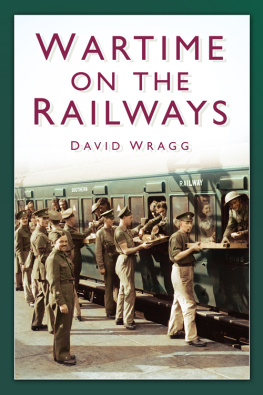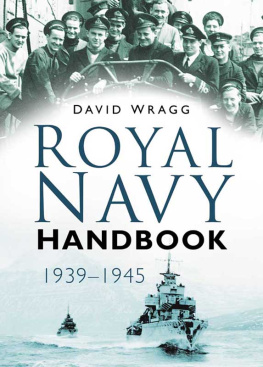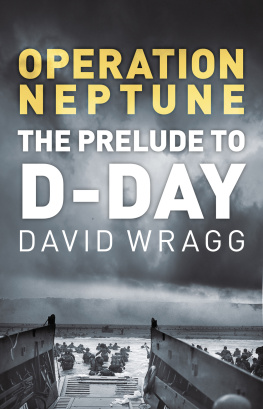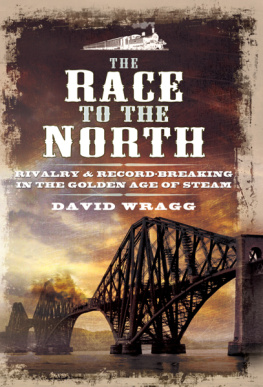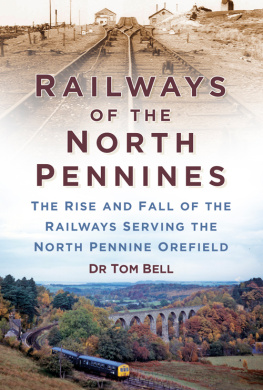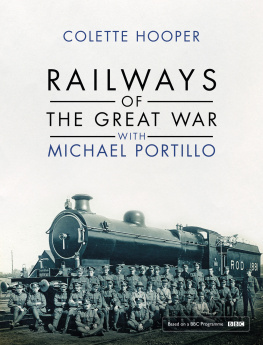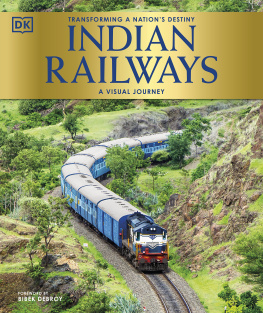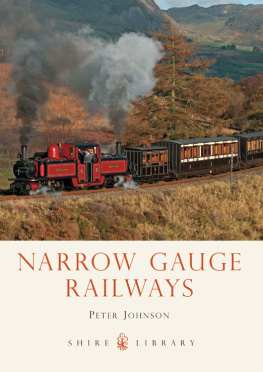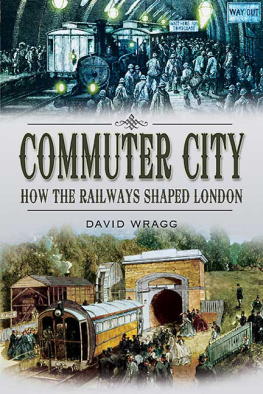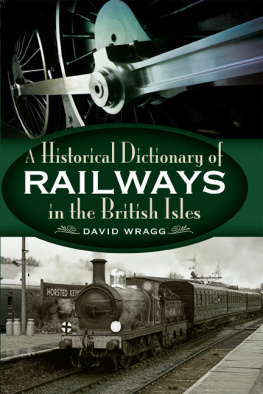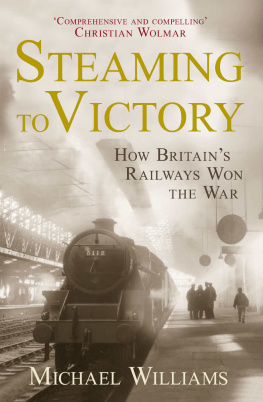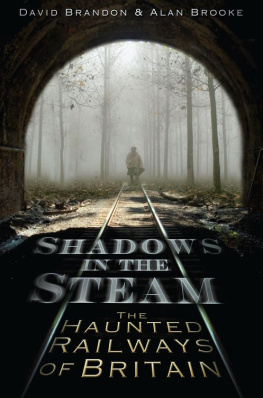
C ONTENTS
Air-raid drill, London Midland & Scottish temporary headquarters, Watford.
Signalwoman Daisy Cook.
Air-raid damage at Liverpool Street station, London.
Evacuees, Euston station.
Bomb damage, Paddington station, London.
Aftermath of an air-raid, Bank station, London, 1941.
Blackout on the Underground.
Air-raid shelter at Elephant & Castle Underground station.
Southern Railway steamer SS Isle of Jersey as a hospital ship.
Gun production at Southern Railways Eastleigh Works.
Wearing gas masks at work.
Spitfire MkV, Flying Scotsman .
Evacuees, Surbiton, 1944.
A BBREVIATIONS
IWM | Imperial War Museum |
NRM | National Railway Museum |
There comes a time when locomotives are more important than guns.
General Erich von Ludendorff, 1918
From the American Civil War onwards, railways have always played an important part in warfare. While the first interest taken by the military in railways in Britain during the mid-nineteenth century was primarily for internal security purposes, by the end of that century the Boer War in southern Africa saw a massive movement of men and their horses via the London & South Western Railway and its port at Southampton. So important were the railways that in the First World War the state took control of them, and then repeated this exercise under somewhat more controversial arrangements on the outbreak of the Second World War.
Wartime on the Railways is an account of the part played by Britains railways during the Second World War, dealing not simply with operational matters or the impact of enemy action on the railways, but also looking at financial arrangements, the part played by railway workshops in producing equipment for the military and the wartime experience of the railways ships, with the narrative augmented by personal accounts from railwaymen. It also shows how the war years saw many jobs traditionally handled by men taken over by women. Not forgotten is the role played by the London Underground, not least in providing air-raid shelters at its deep-level Tube stations, although even these were not as safe from the Luftwaffes bombs as the many Londoners using them believed.
CHAPTER 1
On the morning of 11 May 1941, Mr Greenfield, station master at Waterloo, Londons largest railway terminus, walked along the line from his station to Clapham Junction. It was a bright and sunny spring morning, but not in London. The heavy pall of smoke that hung in the air masked the sunshine, and everywhere there fluttered fragments of burned paper from the many fires. Overwhelming everything was the choking stench of burning. Earlier, trains carrying the national morning newspapers, that were such a feature of night working at Waterloo, had had to start from the suburban main-line stations of Wimbledon and Surbiton. The daily rush of commuters had to alight at Clapham Junction and use a special replacement bus service, but this could not cope as the road leading to Waterloo was cluttered with fire hoses; at one stage, the queue for the railway replacement buses stretched for more than a mile.
The previous night, the Luftwaffe had managed to close not only Waterloo, but also the other Southern Railway termini at Victoria, London Bridge, Charing Cross and Cannon Street, as well as Kings Cross and St Pancras, the Waterloo & City Line, the Bakerloo Line, and the West End branch of the Northern Line.
In earlier centuries, warfare usually paused during the winter months as the belligerents turned their attention to surviving the worst of the weather. Growing mechanisation and new armaments meant that this changed during the twentieth century. Certainly, the winter of 19401 saw some of the worst weather in living memory, but it also saw the Germans continue to attack British towns and cities with unprecedented ferocity, for this was a modern war, and the prime component was air power. The German Luftwaffe had maintained its blitz of British cities from September, only missing a night if the weather intervened.
A IR R AIDS
Once spring arrived, with better weather, the prospect was of more and worse air raids, the only hope being that the shorter nights might make it more difficult for the Luftwaffe to mount heavy bombing raids over the entire country. Naturally enough, as the nations capital and a vital point in the transport network, London had suffered most, but the Luftwaffe had also managed to pay a visit to most other major British cities. It had even reached those that pre-war had been regarded as relatively safe, such as Belfast. On the outbreak of war, children had been evacuated from the cities seen as being most at risk even those in the west such as Glasgow, neighbouring Clydebank, and Liverpool which showed considerable foresight on the part of the authorities, as the Luftwaffe attacked all of these places as well.
Aerial warfare had not come as a surprise. During the years between the two world wars, the belief had grown that the bomber would always get through. Extensive air-raid precautions, or ARP as they were commonly known, had been put in place well before the outbreak of hostilities, urged on by the fear that war might break out suddenly, with a surprise attack without a formal declaration of war. Under public pressure, the deep-level Tube stations of the London Underground had been opened up as additional air-raid shelters where people felt safe, but incidents, as serious damage by bombing was referred to in the official language of wartime, during October 1940 and January 1941 showed the public to have been over-optimistic. As early as October 1940, a bomb penetrated the Northern Line t ube station at Balham in south London, bringing down part of the tunnel and killing seventy-two people, of whom sixty-eight had been seeking shelter. In January 1941, another bomb pierced the road surface outside the Bank of England and the Royal Exchange in the heart of the City of London and exploded at the top of the escalators at Bank station, blowing out the windows of two Central Line t ube trains and wrecking the three escalators. Despite it being a Saturday evening and therefore quieter than on a busy week day, the explosion killed fifty-seven people and injured another sixty-nine. Other t ube stations also suffered. It seemed that nowhere was safe, and that the railways were the main target after the Luftwaffe had tried, and failed, to eliminate the Royal Air Force during the Battle of Britain.
Modern warfare soon showed that it was no respecter of status or rank. Lord Stamp, President of the London Midland & Scottish, the largest business in the British Empire, who had been leading the Railway Companies Association in their negotiations with the government, which wanted to revise its arrangements for the control and use of the railways in wartime, was killed with his family in an air raid during April. Indeed, the night of 16/17 April 1941 was one of the worst of the bombing campaign. In addition to the deaths of Lord and Lady Stamp and their eldest son, there were numerous other incidents, many of them on the railways.
This was the night that a landmine fell on the Hungerford Bridge, which carried the lines from Kent from what is now known as Waterloo East across the River Thames and into the Southern Railway terminus at Charing Cross, which itself was also badly damaged by bombs. Further east along the north bank of the River Thames, the lines into two other Southern termini, Blackfriars and Holborn Viaduct, were cut when a bomb demolished the bridge over Southwark Street on the south bank. A party of men working on the bridge sought refuge in a small metal shelter, but this was caught by the blast and three of them were killed.
Next page
